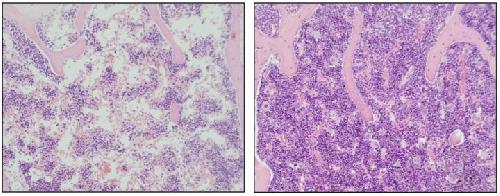Aplastic anaemia is a rare, and potentially fatal, disease of the blood, by which the bone marrow is unable to generate blood cells at the appropriate pace. Many forms of aplastic anaemia share an important link with the ageing process: the shortening of telomeres, structures that protect the ends of chromosomes. Four years ago, a group at the CNIO created a new anti-ageing therapy based on repairing the telomeres. Now, the same researchers have proven that this therapy may be effective against the types of aplastic anaemia caused by short telomeres. It is a completely new strategy against aplastic anaemia.
The treatment is based on making bone marrow cells express the telomerase enzyme, which is responsible for repairing telomeres. In order to achieve this, researchers rely on gene therapy: using a virus as a taxi, they introduce the telomerase gene into the bone marrow cells, which can then repair the telomeres and continue generating blood cells.
"We provide proof-of-concept that the telomerase based treatment (...) has a therapeutic effect on the type of aplastic anaemia caused by short telomeres," the authors state in an article in the journal Blood, with Christian Bär among them as the first author, as well as Juan Manuel Povedano. The study, led by Maria A. Blasco at the CNIO, was also carried out in collaboration with the Universidad Autónoma de Barcelona and Hoffmann-LaRoche (Basel).
 Representative bone marrow images of aplastic anemia (left) and cured anemia upon telomerase gene therapy (right). Credit: CNIO
Representative bone marrow images of aplastic anemia (left) and cured anemia upon telomerase gene therapy (right). Credit: CNIO
INHERITED AND ACQUIRED
Aplastic anaemia can be caused by inherited mutations in about thirty genes (known to date), several of which are involved in preserving the telomeres. Aplastic anaemia may also be acquired by mechanisms that have still not been clearly established, from exposure to certain toxins to viral infections. A common trait in aplastic anaemia, regardless of whether it is inherited or acquired, is the presence of short telomeres.
In 2012, the CNIO Telomeres and Telomerase Group, headed by Maria A. Blasco, came up with a strategy to repair telomeres. The shortening of telomeres is a process that occurs naturally in the body each time that a cell divides: during cell division the DNA, which is tightly packaged into chromosomes, must be duplicated but the DNA-copying machinery design itself, prevents the full replication of the ends of the chromosomes. The telomeres, therefore, become a little bit shorter with each cell division process. As a general rule, the older you are, the shorter the telomeres.
Telomerase, the enzyme that repairs telomeres, is only active during pregnancy; i.e. healthy cells in an adult organism do not express telomerase. There is only one exception: the stem cells that are present in the tissues -- in the case of blood, the bone marrow. Stem cells, which have to divide regularly to regenerate tissues with new cells, can produce telomerase, but not the amount required to counteract the shortening of telomeres that accumulates with ageing: over time, the tissues have fewer fresh cells and they lose their regenerative capacity.
In their research project in 2012, the researchers substantially delayed the ageing of mice by enabling their cells to produce telomerase once again for a period of time. In the paper that is now published, they make the stem cells in the bone marrow to produce more telomerase, thus enabling them to repair their excessively shortened telomeres.
TWO MURINE MODELS
The researchers resorted to two strains of mice that recapitulate the disease in humans. One of them was used to reproduce acquired aplastic anaemia: due to various types of damage, some of the stem cells die, and those that remain need to divide more frequently in order to maintain the production of blood cells; as a result of so many divisions, the telomeres shorten and the disease appears.
In the animal model, the researchers eliminate some of the stem cells by deleting a particular gene in them. After a few weeks, they treat the animals with the telomerase gene therapy.
"Indeed, the treatment [with telomerase] significantly prevents mortality from aplastic anaemia, and lengthens the telomeres in the blood and in bone marrow," say the authors. "In the group that was not treated with the gene therapy, the majority of the animals die from aplastic anaemia, and they also die much sooner."
The second animal model attempts to reproduce hereditary aplastic anaemia, which is produced by mutations associated with the telomeres and telomerase. The researchers used mice in which the telomerase gene was eliminated; specifically in bone marrow cells.
As in the former case, after being treated with telomerase gene therapy "the telomeres in the peripheral blood in these mice also lengthened and the number of blood cells increased considerably," write the authors. "In both models, the increased number of blood cells can be attributed to a greater reserve population of stem cells."
There are types of aplastic anaemia that are not associated with short telomeres. However, the researchers believe that these results are proof of concept that gene therapy is a valid strategy against aplastic anaemia; this therapy could also be applied to other genes -- besides from telomerase -- if a causal role for those other forms of the disease was discovered.
source: Centro Nacional de Investigaciones Oncologicas (CNIO)